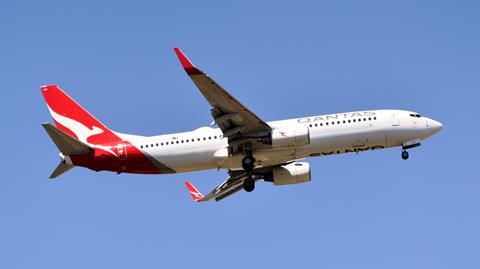A loss of separation between two Qantas Boeing 737-800s at Sydney airport stemmed from one aircraft’s slightly delayed departure and a tardy go-around call-out from air traffic control, Australian investigators have concluded.
In the late afternoon of 29 April 2023, a 737 (VH-VZM) was preparing to take-off from runway 16L, as another of the operator’s 737s (VH-VZW) was on final approach to land on the same runway, according to the Australian Transport Safety Bureau (ATSB).

VZM’s take-off roll was slightly delayed because it took a business jet longer than expected to vacate the runway. In addition, a minor technical fault added a further 4s delay.
As VZM’s departure finally began, the aerodrome controller identified that spacing between it and the arriving aircraft would be compromised.
The controller contacted VZW to issue the go-around instruction, but before doing so the tower shift manager said “wait.” This caused the controller to hesitate, but having received no further clarification, the controller went ahead and issued the order to abort the landing.
The manager subsequently recalled that they had “inadvertently spoken,” and had not intended to delay the transmission of the go-around instruction.
In addition, the controller issued a further command that the crew interpreted as an ammendment to normal missed approach procedures, causing it to continue along the runway track instead of turning left onto a heading of 125°.
“The ATSB identified that the go-around instruction issued by the aerodrome controller was delayed by about 12 seconds due to an inadvertent interjection by the tower shift manager,” says the report.
“The ATSB also found that the instruction issued to the crew of VH-VZW by the aerodrome controller subsequent to the go-around was interpreted as a cancelation of the published missed approach procedure. Consequently, the crew did not turn left at 600ft as required by the procedure and instead continued on the runway track.”
Meanwhile, VZM continued its take-off roll and departed. The ATSB says the controller had sufficient time to instruct the jet to abort its take off, which would have avoided the two aircraft operating in close proximity.
As a result, at around 17:48 local time, the separation between the two aircraft reduced to 0.8nm (1.5km) horizontally and 330ft vertically before VZW turned away to the north. Neither crew received a traffic collision avoidance system warning, and neither had the other aircraft in sight. The Sydney tower, however, could see both aircraft.
As a result of the incident, in which no passengers or crew suffered injuries, Airservices Australia is conducting an analysis of runway occupancy times at Sydney for different types of aircraft, and reviewing other go-arounds at the airport.
Sydney tower will also make adjustments to procedures, particularly around compromised separation training.












































